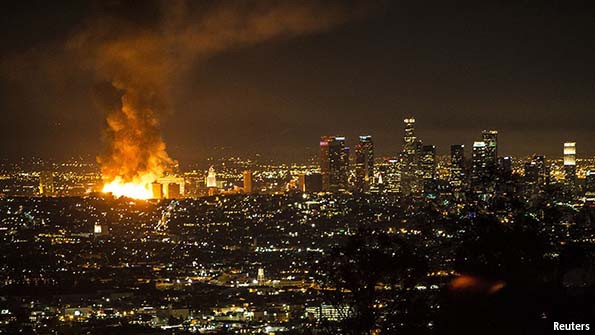Fire Safety
Up in smoke
When high-rise buildings become tinder boxes

THE conflagration that
illuminated the night sky over Los Angeles a few weeks ago—reducing a huge,
half-built apartment block to ashes—has prompted calls for tougher safety
requirements for large timber-frame buildings. Mercifully, it being the middle
of the night, no one was working on the 526-unit Da Vinci apartment complex
when it went up in flames. But the fireball shattered windows of surrounding
high-rise office blocks, rendering them uninhabitable. Firemen and building
inspectors were shocked by the intensity of the blaze.
The building destroyed in Los Angeles’s worst residential fire in ages had five timber-frame storeys—the maximum the city currently permits—sitting on top of two concrete-walled floors. After sifting through some 75,000 square feet (7,000 square metres) of debris, investigators concluded late last week that the fire had been deliberately set. City officials put the cost of the blaze at $20m to $30m, plus damage to surrounding buildings amounting to tens of millions of dollars more. A criminal investigation is now underway.
In America, three structural building materials jostle for primacy, depending on the nature of the edifice proposed. High-rise buildings, including skyscrapers, are usually steel-framed, because of steel's high strength-to-weight ratio as well as the ease with which additional floors can be bolted on top of one another. Concrete, which is less dense than steel but has a much lower strength-to-weight ratio, is a more economical choice for simple structures such as parking garages and other low-lying buildings. And timber has long been the mainstay for one- and two-storey homes. But timber-frame construction, as this recent incident shows, is also now widely used for large apartment blocks and commercial buildings.
For factories, warehouses and other commercial buildings that require spans stretching 100 feet (30 metres) or more, steel is still preferable. It is lighter and stiffer than timber for comparable loads. The components for steel-frame buildings are manufactured off-site to rigid standards and specifications, while the lumber for timber-frame structures is usually cut to fit on-site, resulting in lower tolerances and a lot more waste (20% for wood compared with 2% for steel). Nor do steel-framed buildings warp, twist, split, swell, shrink, suffer from termites and mould, or rot as fast as wooden ones. So nails do not pop up and plaster-work does not crack as the building ages. Overall, steel-frame buildings tend to have a lower lifetime cost of ownership.
One drawback of steel, though, is its thermal conductivity. It can conduct anything from 200 to 1,000 times more heat than wood. This “thermal bridging” effect allows the heat from a fire in one part of a building to spread rapidly through the steel framework to other parts, causing spontaneous ignition elsewhere…
The building destroyed in Los Angeles’s worst residential fire in ages had five timber-frame storeys—the maximum the city currently permits—sitting on top of two concrete-walled floors. After sifting through some 75,000 square feet (7,000 square metres) of debris, investigators concluded late last week that the fire had been deliberately set. City officials put the cost of the blaze at $20m to $30m, plus damage to surrounding buildings amounting to tens of millions of dollars more. A criminal investigation is now underway.
In America, three structural building materials jostle for primacy, depending on the nature of the edifice proposed. High-rise buildings, including skyscrapers, are usually steel-framed, because of steel's high strength-to-weight ratio as well as the ease with which additional floors can be bolted on top of one another. Concrete, which is less dense than steel but has a much lower strength-to-weight ratio, is a more economical choice for simple structures such as parking garages and other low-lying buildings. And timber has long been the mainstay for one- and two-storey homes. But timber-frame construction, as this recent incident shows, is also now widely used for large apartment blocks and commercial buildings.
For factories, warehouses and other commercial buildings that require spans stretching 100 feet (30 metres) or more, steel is still preferable. It is lighter and stiffer than timber for comparable loads. The components for steel-frame buildings are manufactured off-site to rigid standards and specifications, while the lumber for timber-frame structures is usually cut to fit on-site, resulting in lower tolerances and a lot more waste (20% for wood compared with 2% for steel). Nor do steel-framed buildings warp, twist, split, swell, shrink, suffer from termites and mould, or rot as fast as wooden ones. So nails do not pop up and plaster-work does not crack as the building ages. Overall, steel-frame buildings tend to have a lower lifetime cost of ownership.
One drawback of steel, though, is its thermal conductivity. It can conduct anything from 200 to 1,000 times more heat than wood. This “thermal bridging” effect allows the heat from a fire in one part of a building to spread rapidly through the steel framework to other parts, causing spontaneous ignition elsewhere…
No comments:
Post a Comment